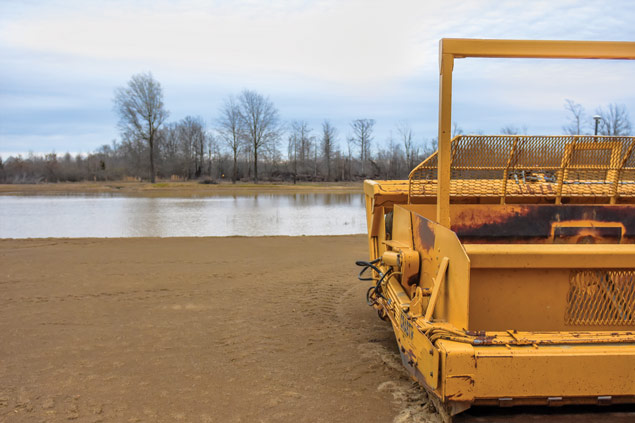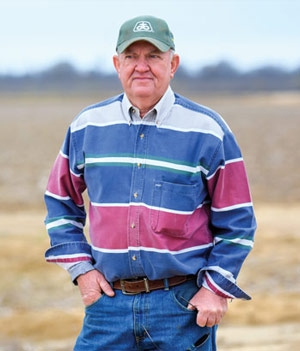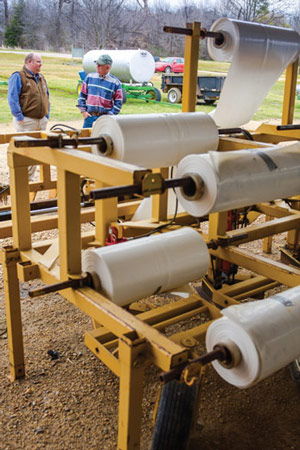
Photos by Mark Johnson
Floyd Anderson uses this clean scraper along with GPS and laser technology to level and shape his cropland.
Most people know that a plant needs three things to grow properly: soil, sun and water. We learn that in grade school, right?
So it comes as no surprise that farmers who grow crops — and even those who raise livestock — focus much of their attention on trying to provide, conserve or enhance those three elements.
In the Mississippi Delta region, however, conservation, distribution and general control of water rule the roost on the agricultural priority list. In fact, the most successful farmers have elevated water conservation to an art form.
Floyd “Porgie” Anderson is one of the best of these “artists.”

Floyd Anderson
Anderson, a longtime customer of Mississippi Land Bank, is well known throughout the rural Inverness, Miss., area as a leading row-crop producer and conservationist. Annually, he grows approximately 2,500 acres of corn and 4,000 acres of soybeans. His yields hover around 195 and 70 bushels for corn and soybeans, respectively.
“It’s all about the water,” says Anderson, who operates the farm with his wife, Penny, and his 18-year-old son, Will, a freshman at Mississippi State University in Starkville. “Back in the 1960s, before we started irrigating, we thought a 40-bushel yield was good for soybeans. These days, we’ve seen as high as 78, and I believe we could hit 100, maybe not in my lifetime, but definitely in Will’s.”
Getting Water Where It Needs to Be
The key, he says, is getting valuable irrigation water into the roots of the plants rather than allowing it to evaporate or end up in the Gulf of Mexico due to excessive runoff.
But that’s easier said than done, according to Rob Taylor, Anderson’s Mississippi Land Bank loan officer for more than 12 years.
“This Delta area, years ago, was temperate swampland,” says Taylor, who is vice president and Cleveland branch manager for the Land Bank. “It was continually flooded by the river, and there was no agriculture. Then folks decided to clear it, build a levy to control the flooding, and create farmland. But it was very dry, and farmers had to just wait for the rain.
“Center pivot irrigation became big in the ’50s and ’60s, but even that isn’t particularly efficient, because you lose a lot to evaporation and you can’t get water everywhere you need it, unless your field is perfectly round,” he says. “Porgie’s approach is what makes the difference.”
Precision Leveling and Furrow Irrigation
Anderson’s approach is to use a combination of precision leveling techniques and furrow irrigation.

After a crop is planted, this poly pipe roller lays down flexible pipe between plant rows for furrow irrigation. Behind the machine, Floyd Anderson, right, visits with Rob Taylor of Mississippi Land Bank.
First, he levels previously rolling fields using pull-behind, bucket-type soil scrapers along with GPS and laser technology, creating a slight fall that is often calculated to the hundredth of an inch. After the field is planted in corn or soybeans with furrows between the rows, collapsible “poly pipe” is unrolled on the uphill side of the rows. Water is pumped into the pipe, and workers punch holes into the 9-millimeter material, allowing water to drain directly into the soil at a prescribed rate. The length of the row determines the size of the hole punched into the pipe.
“If you do it right, you will lose very little water to runoff or evaporation,” says Anderson. “Based on a number of variables that we put into the computer, we get a calculation that tells us exactly the size of the hole to punch for each row, and it is usually pretty accurate.”
Anderson borders the lower perimeter of each field with a ditch that catches any runoff and reroutes it into a central slough, from which he can reuse or “re-lift” the excess water for additional irrigation.

Waterfowl and wildlife numbers have increased on the farms where Anderson has shaped certain fields to drain into natural wetland areas, which are in the Conservation Reserve Program.
“All things being equal, most farmers around here will say there’s a 10- to 15-bushel advantage to using furrow irrigation compared to center pivot,” he says. “There’s just too much evaporation and not enough consistency in getting water in the ground with a center pivot. I’ll never use them again.”
Improving Wildlife Habitat
On one 591-acre farm, Anderson has not only created a more productive operation using precision leveling and furrow irrigation, he is also having a dramatic, positive influence on wildlife, Taylor points out.
More than 200 acres of that farm are in the USDA Conservation Reserve Program (CRP), which reimburses farmers for converting marginal farmland into wildlife habitat for a 10- to 15-year period. Some of that land is on the perimeter of the farm and is prime deer and turkey habitat, while some of the other property such as the slough located in the center of the farm, is useful for both wildlife and water conservation. Anderson formed all of his fields around this central slough, so that any runoff would drain into it.
“This not only retains the habitat for waterfowl much longer, but also allows him to re-lift the surface water for irrigation and conserve the groundwater, which is a big deal here,” Taylor says.
As part of the conservation program, Anderson maintains the CRP areas by seeding a variety of native plant species to provide food and cover for area wildlife.
“There’s deer and turkey all over the place now,” Anderson says. “And I’m always jumping ducks and other waterfowl in that center slough. It’s definitely made a difference.”
"We just try to do what makes the most sense while being good stewards of our land."
- Floyd Anderson
Catfish Ponds Convert to Fertile Farmland
Anderson also has converted several former commercial catfish ponds back into high-yielding farmland, using the resources of a once-booming niche that has all but left the area.
“The catfish industry was a good business around here back in the 1980s and ’90s,” explains Taylor. “Unfortunately, the market became saturated with imported ‘fake’ catfish in the early 2000s, and that essentially destroyed a good thing for local producers. On the positive side, those drained ponds have resulted in very fertile farmland due to all the organic material that built up over time. Porgie has turned a bunch of those old catfish ponds into some extremely productive corn and soybean fields.”
Focusing on good land stewardship is nothing new for Anderson. He has participated in several environmental programs, including the Mississippi Delta Management Systems Evaluations Area, which focused on alternative and innovative farming systems for improved water quality in the late 1990s. His more recent conservation efforts were recognized last year, when he was named the 2016 Conservation Farmer of the Year by The Delta Council, an 80-year-old organization that advocates for agriculture, infrastructure and businesses in the Delta region.
“Sure, I guess it’s a good feeling to be recognized for these things,” says Anderson, who credits Taylor and Mississippi Land Bank for being a trusted and valuable partner. “We just try to do what makes the most sense while being good stewards of our land.”
– Mark Johnson